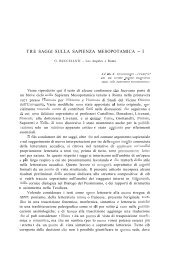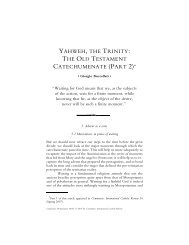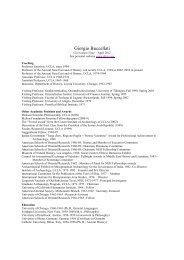Akkadian and Amorite Phonology
Akkadian and Amorite Phonology
Akkadian and Amorite Phonology
You also want an ePaper? Increase the reach of your titles
YUMPU automatically turns print PDFs into web optimized ePapers that Google loves.
<strong>Akkadian</strong> <strong>and</strong> <strong>Amorite</strong> <strong>Phonology</strong> 13Salonen 1962; Jucquois 1966; Hecker 1968; Giakumakis 1970; Wilhelm1970; Mayer 1971).Of fundamental importance for phonology is the study of the cuneiformsyllabary, of which von Soden <strong>and</strong> Rollig 1967 represents the culmination.But it almost looks as though the two fields (grammar <strong>and</strong> syllabary) areconceived apart from each other, so that the full implications for phonologyare not adequately articulated. Note how the major work on Neo-Assyrian"Lautlehre" (Deller 1959) is in fact primarily concerned with orthographyrather than with phonology. It is in this respect that Gelb's contributionst<strong>and</strong>s out as a major methodological undertaking. In his work more thanin any other scholar's the accurate study of the syllabary is merged with asensitive underst<strong>and</strong>ing of phonology, resulting in the most exemplary treatmentof this topic.Several studies on Eblaite (see elsewhere in this volume) touch on questionspertaining to Old <strong>Akkadian</strong>, but an in-depth comprehensive new studyof Old <strong>Akkadian</strong> phonology remains a desideratum, especially consideringthat for Old <strong>Akkadian</strong> itself the documentary database has increased sinceGelb's groundbreaking work. Diakonoff 1985, 1991-92 <strong>and</strong> Faber 1985represent a major step in this direction in terms of linguistic analysis, butthey do not attempt to provide any systematic documentation.In terms of a general treatment of phonology, a special place must be accordedReiner 1966 <strong>and</strong> Diakonoff 1991-92. Reiner's remains to date themost sophisticated linguistic analysis of <strong>Akkadian</strong> phonology; in particularit should be noted that she presented the first, <strong>and</strong> so far only, generativetreatment of <strong>Akkadian</strong> phonology. Diakonoff is far-reaching in his implications,though his very strength (the correlation of <strong>Akkadian</strong> with Afro-Asiatic) limits the range <strong>and</strong> effectiveness of his Assyriological documentation<strong>and</strong> often obscures his elaboration of <strong>Akkadian</strong> phenomena.1.2.4. Phonological studies of <strong>Amorite</strong>The first modern treatment of <strong>Amorite</strong> phonology is Gelb 1958. Ironically,this remains also the only major work to provide a systematic treatment ofthe subject. Garbini has dealt with problems of <strong>Amorite</strong> phonology (1960:19-80,175-77; 1965; 1972: 23-96,141-54), but from the point of view ofspecific comparative concerns. Neither Buccellati 1966 nor Huffmon 1965covers phonology in any systematic way. While the last work by Gelb on<strong>Amorite</strong> (1980) is based on a rigorous underst<strong>and</strong>ing of phonology <strong>and</strong>provides all the essential data for a full discussion of the topic, it does not







